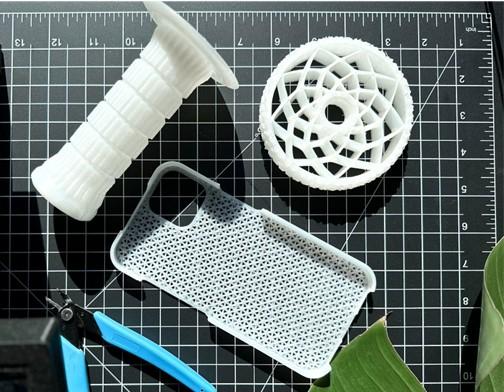Xtellar Launches Biobased EVA Resin for Large-Format 3D Printing

Startup combines Braskem assets with newly acquired Taulman3D business
Newly launched company Xtellar says it has developed an industry-first biobased ethylene vinyl acetate (EVA) resin in pellet form for large-format 3D printing.
Brazil-based petrochemicals giant Braskem, the largest polyolefins producer in the Americas, formed Xtellar (https://www.xtellar.com) by spinning off its specialty materials division into the new company and augmenting that with the December 2022 purchase of Linton, Ind.-based Taulman3D (https://taulman3d.com). Taulman3D is a leading supplier of 3D filaments made from nylon, recycled PETG and PET.
Xtellar Preparing ‘Hard Launch’

Xtellar sees its flexible EVA replacing TPE or TPU in a variety of products.
“We built the brand for eight months, announced the new company at the RAPID + TCT show in early May this year, which I consider the soft launch,” Xtellar CEO Jason Vagnozzi said in a July 14 interview. “The hard, operational launch is coming in Q3 2023,” with production happening at the Taulman3D facility in Indiana. Vagnozzi, a 23-year Braskem veteran, and the commercial team will initially operate the business from the Braskem America offices in Philadelphia.
EVA is a clear, hygroscopic, amorphous elastomeric material that in Xtellar’s formulation is biobased, sourced from sustainable raw sugar cane feedstock. With a lower carbon footprint than traditional fossil fuel-based materials, “this formulation provides a sustainable alternative to traditional flexible TPE and TPU materials currently on the market,” according to Vagnozzi. EVA is said to also offer flexibility, ductility and lightweighting.
Innovating for Market Needs
“We don’t want to launch me-too products, we want to fill a void in the market,” he remarked. “In 2022, we launched the industry’s first biobased polyethylene and flexible EVA 3D printing filaments, and this year we continue our mission by launching the first biobased flexible EVA pellets specifically formulated for large-format 3D printing applications,” Vagnozzi said.
The pellet format helps to lower raw material costs for customers, since it eliminates the need to extrude the resin into filaments, and repackage it, only to melt it again for use in printing.
While large-format 3D printers primarily use pellets, desktop models are now being created for pellets, as well. EVA is widely used in footwear, particularly in shoe soles, and so Xtellar is now able to offer a more sustainable option to those customers. Vagnozzi sees other potential uses in marine and boating applications, such as bumper guards, given EVA’s high impact and water resistance. Xtellar sees potential uses in the automotive, aerospace and industrial sectors.
Braskem (www.braskem.com/usa), meanwhile, continues to work on developing a biobased polypropylene, but that is likely to be a two- to three-year journey, Vagnozzi remarked.
